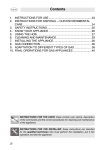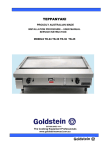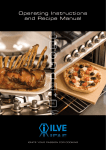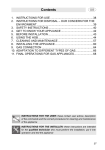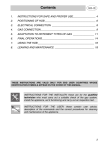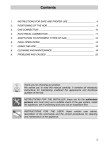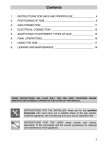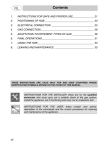Download Smeg PS906 hob
Transcript
Contents 1. INSTRUCTIONS FOR USE ........................................................ 23 2. INSTRUCTIONS FOR DISPOSAL – OUR ENVIRONMENTAL CARE .......................................................................................... 24 3. SAFETY INSTRUCTIONS .......................................................... 25 4. KNOW YOUR APPLIANCE ........................................................ 26 5. BEFORE INSTALLATION........................................................... 26 6. USING THE HOB........................................................................ 27 7. CLEANING AND MAINTENANCE.............................................. 29 8. INSTALLING THE APPLIANCE.................................................. 30 9. GAS CONNECTION ................................................................... 36 10. ADAPTATION TO DIFFERENT TYPES OF GAS ......................38 11. FINAL OPERATIONS FOR GAS APPLIANCES ........................ 40 INSTRUCTIONS FOR THE USER: these contain user advice, description of the commands and the correct procedures for cleaning and maintenance of the appliance. INSTRUCTIONS FOR THE INSTALLER: these instructions are intended for the qualified technician who must perform the installation, put it into operation and test the appliance. 22 Precautions for use 1. INSTRUCTIONS FOR USE THIS MANUAL IS AN INTEGRAL PART OF THE APPLIANCE. IT MUST BE KEPT IN ITS ENTIRETY AND IN AN ACCESSIBLE PLACE FOR THE WHOLE WORKING LIFE OF THE HOB. WE URGE YOU TO READ THIS MANUAL AND ALL THE INFORMATION IT CONTAINS CAREFULLY BEFORE USING THE APPLIANCE. INSTALLATION MUST BE CARRIED OUT BY QUALIFIED PERSONNEL IN ACCORDANCE WITH THE REGULATIONS IN FORCE. THIS APPLIANCE IS INTENDED FOR DOMESTIC USES AND CONFORMS TO THE EEC DIRECTIVES CURRENTLY IN FORCE. THE APPLIANCE HAS BEEN BUILT TO CARRY OUT THE FOLLOWING FUNCTIONS: COOKING AND HEATING-UP OF FOOD; ALL OTHER USES ARE CONSIDERED IMPROPER. THE MANUFACTURER DECLINES ALL RESPONSIBILITY FOR IMPROPER USE. DO NOT USE THIS APPLIANCE FOR HEATING ROOMS. DO NOT DISCARD PACKING IN THE HOME ENVIRONMENT. SEPARATE THE VARIOUS WASTE MATERIALS AND TAKE THEM TO THE NEAREST SPECIAL GARBAGE COLLECTION CENTRE. WHEN DISPOSING OF THE APPLIANCE IT MUST BE TAKEN TO A SPECIAL GARBAGE COLLECTION CENTRE. DO NOT OBSTRUCT VENTILATION OPENINGS AND HEAT DISPERSAL SLITS. THE IDENTIFICATION PLATE WITH THE TECHNICAL DATA, SERIAL NUMBER AND MARK IS IN A VISIBLE POSITION UNDER THE CASING. THE PLATE MUST NOT BE REMOVED. 23 Instructions for disposal 2. INSTRUCTIONS FOR DISPOSAL ENVIRONMENTAL CARE – OUR Our product's packing is made of non-polluting materials, therefore compatible with the environment and recyclable. Please help by disposing of the packing correctly. Find the addresses of collection, recycling and disposal centres from your retailer or from the competent local organisations. Do not throw the packing or any part of it away. They can constitute a suffocation hazard for children, especially the plastic bags. Your old appliance also needs to be disposed of correctly. Important: hand over your appliance to the local agency authorised for the collection of household appliances no longer in use. Correct disposal means intelligent recycling of valuable materials. It is also necessary to cut the electric power cord and remove it along with the plug. 24 Safety instructions 3. SAFETY INSTRUCTIONS REFER TO THE INSTALLATION INSTRUCTIONS FOR THE SAFETY REGULATIONS FOR ELECTRIC OR GAS APPLIANCES AND VENTILATION FUNCTIONS. IN YOUR INTERESTS AND FOR YOUR SAFETY IT HAS BEEN ESTABLISHED BY LAW THAT THE INSTALLATION AND SERVICING OF ALL ELECTRICAL APPLIANCES IS TO BE CARRIED OUT BY QUALIFIED PERSONNEL IN ACCORDANCE WITH THE REGULATIONS IN FORCE. OUR REGULAR INSTALLERS GUARANTEE A SATISFACTORY JOB. GAS OR ELECTRIC APPLIANCES MUST ALWAYS BE DISCONNECTED BY SUITABLY SKILLED PEOPLE. THE PLUG TO BE CONNECTED TO THE POWER CORD AND ITS SOCKET MUST BE OF THE SAME TYPE AND CONFORM TO THE REGULATIONS IN FORCE. THE SOCKET MUST BE ACCESSIBLE AFTER THE APPLIANCE IS BUILT IN. NEVER UNPLUG BY PULLING ON THE CABLE. IT IS OBLIGATORY FOR ALL ELECTRICAL SYSTEMS TO BE GROUNDED ACCORDING TO THE METHODS REQUIRED BY SAFETY RULES. IMMEDIATELY AFTER INSTALLATION CARRY OUT A BRIEF INSPECTION TEST, FOLLOWING THE INSTRUCTIONS BELOW. SHOULD THE APPLIANCE NOT FUNCTION, DISCONNECT IT FROM THE ELECTRICITY SUPPLY AND CALL THE NEAREST TECHNICAL ASSISTANCE CENTRE. NEVER ATTEMPT TO REPAIR THE APPLIANCE. THE APPLIANCE BECOMES VERY HOT DURING USE. SUITABLE HEAT-PROOF GLOVES SHOULD BE WORN FOR ALL OPERATIONS. THE APPLIANCE IS DESIGNED FOR USE BY ADULTS. KEEP CHILDREN AT A SAFE DISTANCE AND NEVER ALLOW THEM TO PLAY WITH IT. ALWAYS CHECK THAT THE CONTROL KNOBS ARE IN THE 0 (OFF) POSITION WHEN YOU FINISH USING THE APPLIANCE. The manufacturer declines all responsibility for damage to persons or things caused by the non-observance of the above prescriptions or deriving from tampering with any part of the appliance or by the use of non-original spares. 25 Instructions for the user 4. KNOW YOUR APPLIANCE Auxiliary Burner (AUX) Rapid Burner (R) Ultra-rapid Burner (URP) 5. BEFORE INSTALLATION Do not discard packing in the home environment. Separate the various waste materials and take them to the nearest special garbage collection centre. In order to remove all manufacturing residues, it is recommended to clean the appliance. For further information on cleaning see point "7. CLEANING AND MAINTENANCE". Before using the electric plates or the barbecue (if included) for the first time, pre-heat them to the maximum temperature long enough to burn off any manufacturing oily residues which could give the food a bad taste. 26 Instructions for the user 6. USING THE HOB 6.1 Gas hob Before lighting the hob burners check that the flame diffuser rings are correctly in place with their respective burner caps, making sure that the holes A in the flame diffusers are aligned with the plugs and thermocouples. For the dual burner UR2, place the burner caps G and F on the burner D, ensuring that they fit snugly. The burner must then be placed on and fitted into the base B (taking care to use the pin C as reference). The pan stand B supplied is for use with woks. The special pan stand H is for use with woks. The burner controlled by each knob is shown next to the knob. The appliance is equipped with an electrical ignition device. Simply press the knob and turn it anti-clockwise to the maximum flame symbol, until the burner lights. If it does not light in the first 15 seconds, position the knob on 0 and wait at least 60 seconds before trying to light it again. On valved models, once the burner is lit, keep the knob pressed for a few seconds to give the thermocouple time to heat up. The burner may go out when the knob is released: in this case, the thermocouple has not heated up sufficiently. Wait a few moments and repeat the operation keeping the knob pressed for a longer time. This is not necessary on burners that are not equipped with thermocouple. Once the burner is lit, the flame can be adjusted as needed. Always check that the control knobs are in the (off) position when you finish using the hob. If the burners should go out accidentally, after about 20 seconds a safety device will be tripped, cutting off the gas supply, even if the gas tap is open. In this case, turn the knob to the OFF position and wait at least 60 seconds before trying to light the burner again. 27 Instructions for the user 6.2 Practical tips for using the burners For better burner efficiency and to minimise gas consumption, use pans with a flat, smooth base and a lid that have a suitable size for the burner, thus avoiding that the flames reach the sides of the pan (see point "6.3 Pan diameters"). Once the contents come to the boil, turn down the flame far enough to prevent the liquid from boiling over. To prevent burns or damage to the hob during cooking, all pans or griddle plates must be placed inside the perimeter of the hob. Take the greatest care when using fats or oils since they may catch fire if overheated. 6.3 Pan diameters BURNERS 1 2 3 Auxiliary Rapid Ultra-rapid MIN. AND MAX. Ø (IN CM) 12 - 16 18 - 26 20 - 31 The following are the diameters of the pans that can be used with the raised pan stand: BURNERS 1 2 Auxiliary Rapid MIN. AND MAX. Ø (IN CM) 16 - 24 26 - 28 If you have the Tepanyaki plate (optional extra) never use it on the ultrarapid burner for any reason. Warning: At the end of cooking using pans with aluminium bases you may find white residues on the cast iron pan stands. These residues are usually caused by the pan base rubbing against the pan stand and are difficult to remove with normal cleaning. Using abrasive or excessively aggressive products to clean the pan stand could damage its enamel surface. 28 Instructions for the user 7. CLEANING AND MAINTENANCE NEVER USE A JET OF STEAM FOR CLEANING THE APPLIANCE. Before performing any operations requiring access to powered parts, switch off the power supply to the appliance. 7.1 Cleaning stainless steel To keep stainless steel in good condition it should be cleaned regularly after use. Let it cool first. 7.1.1 Ordinary daily cleaning To clean and preserve the stainless steel surfaces, use only specific products that do not contain abrasives or chlorine-based acids. How to use: pour the product onto a damp cloth and wipe the surface, rinse thoroughly and dry with a soft cloth or deerskin. 7.1.2 Food stains or residues Do not use metallic sponges or sharp scrapers: they will damage the surface. Use ordinary non-abrasive products for cleaning steel, with the aid of wooden or plastic utensils if necessary. Rinse thoroughly and dry with a soft cloth or deerskin. 7.2 Cleaning the gas components For easier cleaning the pan stands, burner caps, flame spreader crowns and burners can all be removed; wash them with warm water and a nonabrasive detergent making sure to remove any encrustation and wait until they are perfectly dry. Replace the burner caps on their corresponding crowns, making sure that the slots A are centred with the burner pins B. For correct operation the igniters and thermocouples must always be perfectly clean. Check them frequently and clean them with a damp cloth if necessary. Remove any dry residues with a wooden toothpick or a needle. 29 Instructions for the installer 8. INSTALLING THE APPLIANCE 8.1 Positioning in the counter top This is a class 3 appliance. The following operation requires building and/or carpentry work, therefore it must be carried out by a skilled technician. Installation can be carried out on various materials such as masonry, metal, solid wood or plastic laminated wood as long as they are heat resistant (T 90°C). 8.1.1 Fixing to the supporting structure Create an opening in the counter top with the dimensions shown in the figure, keeping a minimum distance of 50 mm from the rear edge. This appliance can be mounted against walls higher than the work surface on condition that a distance of "X" be kept between the appliance and the wall as shown in the figure so as to avoid damage from overheating. Make sure that there is a minimum of 750 mm (Fig1) between the hob and any shelf that may be installed directly above it. Carefully position the supplied insulating seal (E) on the outer perimeter of the hole made in the counter top, trying to make it stick on the entire surface by applying light pressure on it with your hands. Once the hob is fixed in position remove excess material using a cutter. 30 Instructions for the installer To fix the hob solidly to the counter top use the 10 supplied brackets, tightening their screws to lock the product firmly in position. The following figures show how to attach these brackets to the lower casing of the product. This appliance can also be installed in a 90 cm base. To fit the brackets the hob must be inserted into the opening made in the counter top, with the edge resting on the actual top. To bracket the hob laterally, just fix the two “L” brackets to the sides of the unit (A) using the supplied screws (1) making sure to align the slot (B) on the bracket with the rivet (C) on the bottom of the product. Stabilise the fixing of the hob by tightening the screw (2) in the rivet (C). Complete the bracketing of the front and rear part of the hob as described in the previous point. 31 Instructions for the installer 8.1.2 Fixing to the electric model support structure Create an opening in the counter top with the dimensions shown in the figure, keeping a minimum distance of 50 mm from the rear edge. The lower part of the casing must be fully accessible after the appliance has been installed. This appliance can be mounted against walls higher than the work surface on condition that a distance of “X” be kept between the appliance and the wall as shown in the figure so as to avoid damage from overheating. Make sure that there is a minimum of 750 mm (Fig. 1) between the hob and any shelf that may be installed directly above it. This type of appliance also requires milling to a depth of 3 mm on the counter top with the dimensions shown in figure 2 (detail A). Before positioning the hob, the supplied adhesive sponge “E” (fig. 2) must be spread out over the entire surface of the milling. 2) 51 84 E 2 90 0 9 48 51 0 3 R 14.5 87 90 3 90 32 8 1 0 A 49 0 60 A 0 73 Instructions for the installer To fix the hob solidly to the counter top use the 10 supplied brackets, tightening their screws to lock the product firmly in position. The following figures show how to attach these brackets to the lower casing of the product. This appliance can also be installed in a 90 cm base. To fit the brackets the hob must be inserted into the opening made in the counter top, with the edge resting on the actual top. To bracket the hob laterally, just fix the two “L” brackets to the sides of the unit (A) using the supplied screws (1) making sure to align the slot (B) on the bracket with the rivet (C) on the bottom of the product. Stabilise the fixing of the hob by tightening the screw (2) in the rivet (C). Complete the bracketing of the front and rear part of the hob as described in the previous point. 33 Instructions for the installer Important: other types of installation are possible if supervised by the manufacturer. Important: for fixing this appliance to the support structure, you are advised not to use mechanical or electrical screwdrivers and to exert moderate pressure by hand on the mounting parts. Important: for fixing the appliance, use the supplied brackets in all the fixing points. If this appliance is installed over an oven, the oven must have a cooling fan. Important (only for Ultra-rapid burners (UR3) (5) with raised pan stands): if the appliance is mounted on a unit, make sure that a separating shelf is installed, as shown in the figure. If the appliance is instead on an oven installed under the hob, there is no need to install a separating shelf. If installed over an oven, the oven must have a cooling fan. 8.2 Electrical connection Make sure that the voltage and capacity of the power line conform to the data shown on the plate located under the casing. Do not remove this plate for any reason. The appliance must be connected to earth in compliance with electrical system safety regulations. If a fixed connection is being used, fit the power line with an omnipolar circuit breaker with a contact opening gap equal to or greater than 3 mm, in an easily accessible position close to the appliance. 34 Instructions for the installer If a plug and socket connection is being used make sure that the plug and socket are compatible. Avoid use of adapters and shunts as these could cause overheating and burns. Operation at 220-240 V~: use a three-core cable of the type H05V2V2-F (3 x 1.5 mm2 cable for electric hobs and 3 x 0.75 mm2 cable for gas hobs) The end to be connected to the appliance must be an earth wire (yellow-green) at least 20 mm longer. The manufacturer declines all responsibility for damage to persons or things caused by the non-observance of the above prescriptions or deriving from tampering with any part of the appliance. 35 Instructions for the installer 9. GAS CONNECTION Before installation, make sure that the local distribution conditions (nature and pressure of the gas) and the state of regulation of the appliance are compatible. Connection to the gas supply network can be made using a rigid copper hose or a flexible steel hose with a continuous wall and in compliance with the guidelines established by the standard UNI-CIG 7129. Once the operation is complete, check the hose fittings for leaks using a soapy solution; never use a flame. The cooker hob is preset for natural gas G20 (2H) at a pressure of 20 mbar. For supplying it with other types of gas, see chapter "10. ADAPTATION TO DIFFERENT TYPES OF GAS". The gas inlet connection is threaded ½” external gas (ISO 228-1). Connection with rigid copper hose: The connection to the gas supply network must be carried out in such a way that it does not cause stresses of any type on the appliance. The connection can be made using the adapter unit D with double cone, always inserting the supplied gasket C in between. Connection with flexible steel hose: Use only continuous wall stainless steel hoses that comply with standard UNI-CIG 9891, making sure to always insert the supplied gasket C between the connection A and the flexible hose B. Installation with the flexible hose must be carried out so that the length of the piping does not exceed 2 metres fully extended; make sure that the hoses do not come into contact with moving parts and that they are not crushed in any way. 9.1 Connection to liquid gas Use a pressure regulator and make the connection on the gas cylinder following the guidelines established by the regulations in force. Make sure that the supply pressure complies with the values indicated in the table at point "10.2 Burner and nozzle characteristics table". 36 Instructions for the installer 9.2 Room ventilation The appliance may only be installed in permanently ventilated rooms, as specified by the standard UNI-CIG 7129 / 7131. In the room where the appliance is installed, there must be an adequate air flow to meet the requirements of normal gas combustion and the necessary ventilation of the room itself. The air vent, protected by grilles, must be suitably dimensioned (UNI CIG 7129 / 7131) and positioned so that no part of it is obstructed, even partially. The room must be kept adequately ventilated in order to eliminate the heat and humidity produced by cooking: in particular, after prolonged use, it is recommended to open a window or to increase the speed of any ventilators. 9.3 Extraction of the products of combustion Extraction of the products of combustion must be ensured by means of hoods connected to a natural draught chimney whose efficiency is assured or via forced extraction. An efficient extraction system requires precision planning by a specialist qualified in this area and must comply with the positions and distances indicated by the regulations. When the job is complete, the installer must issue a certificate of conformity. 37 Instructions for the installer 10. ADAPTATION TO DIFFERENT TYPES OF GAS Before carrying out the following operations, disconnect the appliance from the electricity supply. The appliance is tested for natural gas G20 (2H) at a pressure of 20 mbar. In the case of operation with other types of gas the burner nozzles must be changed and the minimum flame adjusted on the gas taps. To change the nozzles, proceed as described below. 10.1 Replacement of nozzles on the cooker hob 1 2 3 Extract the grids and remove all the caps and flame-spreader crowns; Unscrew the burner nozzles with a 7 mm socket wrench; Replace the burner nozzles according to the type of gas to be used (see point "10.2 Burner and nozzle characteristics table"). 4 Replace the burners in the correct position. The nozzles for using town gas (G110 – 8 mbar) are available from authorised service centres. 38 Instructions for the installer 10.2 Burner and nozzle characteristics table RATED HEATING Burner LIQUID GAS – G30/G31 28/37 mbar CAPACITY (KW) Nozzle diameter 1/100 mm By-pass 1/100 mm Reduced flowrate (W) Flowrate g/h G30 Flowrate g/h G31 Auxiliary (1) 1.05 50 30 400 76 75 Rapid (2) 2.5 79 42 800 182 179 Ultra-rapid int. (3) 0.9 46 30 400 65 64 Ultra-rapid ext. (4) 3.6 68+68 63 1600 262 257 RATED HEATING Burner CAPACITY NATURAL GAS – G20 20 mbar (KW) Nozzle diameter 1/100 mm Reduced flowrate (W) Auxiliary (1) 1.05 72 400 Rapid (2) 2.5 108 800 Ultra-rapid int. (4) 0.9 70 400 Ultra-rapid ext. (4) 3.6 102+102 1600 To identify the burners on your cooker hob, refer to the drawings in point "4. KNOW YOUR APPLIANCE". 39 Instructions for the installer 11. FINAL OPERATIONS FOR GAS APPLIANCES After making the adjustments described above, reassemble the appliance by following the instructions in point "10.1 Replacement of nozzles on the cooker hob" in reverse order. After adjustment with a gas other than the preset one, replace the label on the casing of the appliance with the label corresponding to the new gas. This label can be obtained from the nearest Authorised Service Centre. 11.1 Adjusting the minimum for town and natural gas Light the burner and turn it to the minimum position. Extract the gas tap knob and turn the adjustment screw inside or next to the tap rod (depending on the model) until the correct minimum flame is achieved. Refit the knob and verify that the burner flame is stable (turning the knob rapidly from the maximum to the minimum position the flame must not go out). Repeat the operation on all the gas taps. 11.2 Adjusting the minimum for liquid gas To adjust the minimum with liquid gas, you must fully tighten the screw inside or next to the tap rod (depending on the model) in a clockwise direction. The bypass diameters for each individual burner are shown in the table "10.2 Burner and nozzle characteristics table". 11.3 Lubrication of gas taps Over time the gas taps may become difficult to turn and get blocked. Clean them internally and replace the lubrication grease. This operation must be carried out by a specialised technician. 40



















